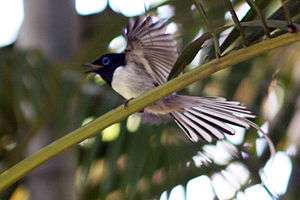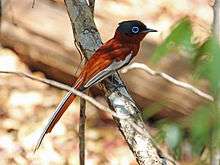Malagasy paradise flycatcher
| Malagasy paradise flycatcher | |
|---|---|
 | |
| Male white phase Terpsiphone mutata singetra | |
| Scientific classification | |
| Kingdom: | Animalia |
| Phylum: | Chordata |
| Class: | Aves |
| Order: | Passeriformes |
| Family: | Monarchidae |
| Genus: | Terpsiphone |
| Species: | T. mutata |
| Binomial name | |
| Terpsiphone mutata (Linnaeus, 1766) | |
| Subspecies | |
|
See text | |
| Synonyms | |
| |
The Malagasy paradise flycatcher (Terpsiphone mutata) is a species of bird in the family Monarchidae. It is found in Comoros, Madagascar, and Mayotte. Its natural habitats are subtropical or tropical dry forests and subtropical or tropical moist lowland forests.
Taxonomy and Systematics
When Carl Linnaeus first described the Malagasy paradise flycatcher in 1766, he assigned it to the genus Muscicapa, which contained many of the Old World flycatchers. The species remained in that genus until 1827, when Constantin Wilhelm Lambert Gloger created the genus Terpsiphone for the paradise flycatchers.[2] The genus name Terpsiphone comes from the Greek words terpsi, meaning "delighted in" (from terpo, "to delight") and phone, meaning "voice".[3] The species name, mutata is Latin for "changed" or "different".[4] An alternate common name is the Madagascar paradise flycatcher.
The Malagasy paradise flycatcher is thought to have evolved from African ancestors, as it appears to be more closely related to the African paradise flycatcher than the Indian paradise flycatcher.[5]
Subspecies
There are five subspecies recognized, which differ only slightly in appearance:[6]
- T. m. mutata - (Linnaeus, 1766): Found in Madagascar. Includes T. m. singetra
- T. m. pretiosa - (Lesson, 1847): Originally described as a separate species. Found on Mayotte in the eastern Comoros
- T. m. vulpina - (Edward Newton, 1877): Originally described as a separate species. Found on Anjouan in the central Comoros
- T. m. voeltzkowiana - (Stresemann, 1924): Found on Mohéli in the west-central Comoros
- T. m. comorensis (sometimes misspelled comoroensis) - (Milne-Edwards and Oustalet, 1885): Originally described as a separate species. Found on Grand Comore in the western Comoros
Description

The Malagasy paradise flycatcher is a medium-sized passerine, measuring 18 cm (7.1 in) in length and weighing between 12.1 and 12.3 g (0.43 and 0.43 oz). Males have long tail plumes, which can add as much as 18 cm (7.1 in) to their overall length. The female is largely rufous-orange, with a black head and nape. The flight feathers on her wings are black with rufous edges, and she has a thin, light blue eyelid wattle.[2]
Range and habitat
This species is a regional endemic found on Madagascar, Mayotte and the Comoros islands. It is common in all native forest types except montane forest, at elevations ranging from sea level to 1,600 m (5,200 ft).[7] It also occurs, though less frequently, in other wooded habitats, including plantations, gardens and secondary forest.[8]
Behavior
Food and feeding
Like all members of its genus, the Malagasy paradise flycatcher is an insectivore, feeding on a variety of insects.[7] It regularly joins mixed-species flocks, particularly those containing common newtonias. It is a "follower" in such flocks, allowing other birds to work as "beaters"; it follows them and hunts down any insect prey they flush. Studies have shown that the paradise flycatcher's foraging efficiency is directly correlated to the number of common newtonia in a flock; a greater number of common newtonias results in a higher foraging efficiency for any accompanying Malagasy paradise flycatchers. When rufous vangas, which generally forage within a meter (yard) or so of the ground, are present in the same mixed-species flocks as Malagasy paradise flycatchers, the latter preferentially follow the vangas, and therefore forage closer to the ground than they normally do.[9]
Breeding
_nesting_female.jpg)
The female typically lays a clutch of three eggs measuring 0.72–0.76 inches (18–19 mm) in length and 0.55–0.57 inches (14 mm) in width. These range in color from pinkish-white to salmon-pink, with dense brown or lavender speckling or blotching on the wide end of the egg.[10] This species occasionally serves as host to the Madagascan cuckoo, a brood parasite.[11]
Conservation and threats
The IUCN rates the Malagasy paradise flycatcher as a species of Least Concern. Despite the fact that its numbers appear to be decreasing, the decline is not precipitous, the species is still common on Madagascar and its global range is sizable.[1]
A number of diurnal raptors, including Frances's sparrowhawk, yellow-billed kite and Madagascar harrier-hawk hunt Malagasy paradise flycatchers.[12] In addition, there is at least one record of a common brown lemur eating a nestling Malagasy paradise flycatcher, one of the few records of a wild lemur eating anything other than plant material.[13]
References
- 1 2 BirdLife International (2012). "Terpsiphone mutata". IUCN Red List of Threatened Species. Version 2013.2. International Union for Conservation of Nature. Retrieved 26 November 2013.
- 1 2 Coates, Dutson & Filardi, p. 293–294.
- ↑ Jobling (2010), p. 382.
- ↑ Jobling (2010), p. 263.
- ↑ Coates, Dutson & Filardi, p. 249.
- ↑ "IOC World Bird List 6.4". IOC World Bird List Datasets. doi:10.14344/ioc.ml.6.4.
- 1 2 Morris, Pete; Hawkins, Frank (1998). Birds of Madagascar: A Photographic Guide. Mountsfield, UK: Pica Press. p. 284. ISBN 1-873403-45-3.
- ↑ Sinclair, Ian; Langrand, Olivier (2003). Birds of the Indian Ocean Islands. Cape Town, South Africa: Struik. p. 138. ISBN 1-86872-956-7.
- ↑ Yamagishi, Satoshi (2005). Social Organization of the Rufous Vanga: The Ecology of Vangas — Birds Endemic to Madagascar. Sakyo-Ku, Japan: Kyoto University Press. pp. 68–71. ISBN 1-920901-04-3.
- ↑ Oates, Eugene W. (1903). Catalogue of the Collection of Birds' Eggs in the British Museum, volume 3. London, UK: British Museum (Natural History). p. 281.
- ↑ Langrand, Olivier (1990). Guide to the Birds of Madagascar. New Haven, CT: Yale University Press. p. 213. ISBN 0-300-04310-4.
- ↑ Ito, Ryo; Mori, Akira (22 April 2010). "Vigilance against predators induced by eavesdropping on heterospecific alarm calls in a non-vocal lizard Oplurus cuvieri cuvieri (Reptilia: Iguania)". Proceedings of the Royal Society B. 277 (1685): 1275–1280. PMC 2842824
 . PMID 20031993. doi:10.1098/rspb.2009.2047.
. PMID 20031993. doi:10.1098/rspb.2009.2047. - ↑ Mizuta, T. (2002). "Predation by Eulemur fulvus fulvus on a Nestling of Terpsiphone mutate (Aves: Monarchidae) in Dry Forest in North-Western Madagascar" (Abstract). Folia Primatologica. 73 (4): 217–219. doi:10.1159/000065427.
| Wikimedia Commons has media related to Terpsiphone mutata. |
Cited works
- Coates, B. J.; Dutson, G. C. L.; Filardi, C. E. (2006). "Family Monarchidae (Monarch-Flycatchers)". In del Hoyo, Josep; Elliott, Andrew; Christie, David. Handbook of Birds of the World, Volume 11: Old World Flycatchers to Old World Warblers. Barcelona, Spain: Lynx Edicions. ISBN 84-96553-06-X.
- Jobling, James A. (2010). The Helm Dictionary of Scientific Bird Names. London, UK: Christopher Helm. ISBN 978-1-4081-2501-4.
